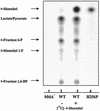Mutations which uncouple transport and phosphorylation in the D-mannitol phosphotransferase system of Escherichia coli K-12 and Klebsiella pneumoniae 1033-5P14
- PMID: 12644498
- PMCID: PMC151505
- DOI: 10.1128/JB.185.7.2267-2276.2003
Mutations which uncouple transport and phosphorylation in the D-mannitol phosphotransferase system of Escherichia coli K-12 and Klebsiella pneumoniae 1033-5P14
Abstract
Mutants of Escherichia coli K-12 were isolated which lack the normal phosphotransferase system-dependent catabolic pathway for D-mannitol (Mtl). In some mutants the pts genes for the general proteins enzyme I and histidine protein of the phosphoenolpyruvate-dependent carbohydrate phosphotransferase systems were deleted. Other mutants expressed truncated mannitol-specific enzymes II (II(Mtl)) which lacked the IIA(Mtl) or IIBA(Mtl) domain(s), and the mtlA genes originated either from E. coli K-12 or from Klebsiella pneumoniae 1033-5P14. The dalD gene from Klebsiella oxytoca M5a1 was cloned on single-copy plasmids and transformed into the strains described above. This gene encodes an NAD-dependent D-arabinitol dehydrogenase (DalD) which converts D-arabinitol into D-xylulose and also converts D-mannitol into D-fructose. The different strains were used to isolate mutations which allow efficient transport of mannitol through the nonphosphorylated II(Mtl) complexes by selecting for growth on this polyhydric alcohol. More than 40 different mutants were analyzed to determine their ability to grow on mannitol, as well as their ability to bind and transport free mannitol and, after restoration of the missing domain(s), their ability to phosphorylate mannitol. Four mutations were identified (E218A, E218V, H256P, and H256Y); all of these mutations are located in the highly conserved loop 5 of the IIC membrane-bound transporter, and two are located in its GIHE motif. These mutations were found to affect the various functions in different ways. Interestingly, in the presence of all II(Mtl) variants, whether they were in the truncated form or in the complete form, in the phosphorylated form or in the nonphosphorylated form, and in the wild-type form or in the mutated form, growth occurred on the low-affinity analogue D-arabinitol with good efficiency, while only the uncoupled mutated forms transported mannitol at a high rate.
Figures


References
-
- Aulkemeyer, P., R. Ebner, G. Heilenmann, K. Jahreis, K. Schmid, S. Wrieden, and J. W. Lengeler. 1991. Molecular analysis of two fructokinases involved in sucrose metabolism of enteric bacteria. Mol. Microbiol. 5:2913-2922. - PubMed
-
- Ausubel, F. A., R. Brent, R. E. Kingston, D. D. Moore, J. G. Seidmann, J. A. Smith, and K. Struhl (ed.). 1990. Current protocols in molecular biology. Greene Publishing and Wiley-Interscience, New York, N.Y.
-
- Boer, H., R. H. ten Hoeve-Duurkens, and G. T. Robillard. 1996. Relation between the oligomerization state and the transport and phosphorylation function of the Escherichia coli mannitol transport protein: interaction between mannitol-specific enzyme II monomers studied by complementation of inactive site-directed mutants. Biochemistry 35:12901-12908. - PubMed
-
- Budde, A. 1991. Genetische and biochemische Analyse der Pentitol- und Hexitoltransport-systeme und -stoffwechselwege in Stämmen von Escherichia coli. Diploma thesis. Universität Osnabrück, Osnabrück, Germany.
-
- Buhr, A., G. A. Daniels, and B. Erni. 1992. The glucose transporter of Escherichia coli. Mutants with impaired translocation activity that retain phosphorylation activity. J. Biol. Chem. 267:3847-3851. - PubMed
Publication types
MeSH terms
Substances
LinkOut - more resources
Full Text Sources

